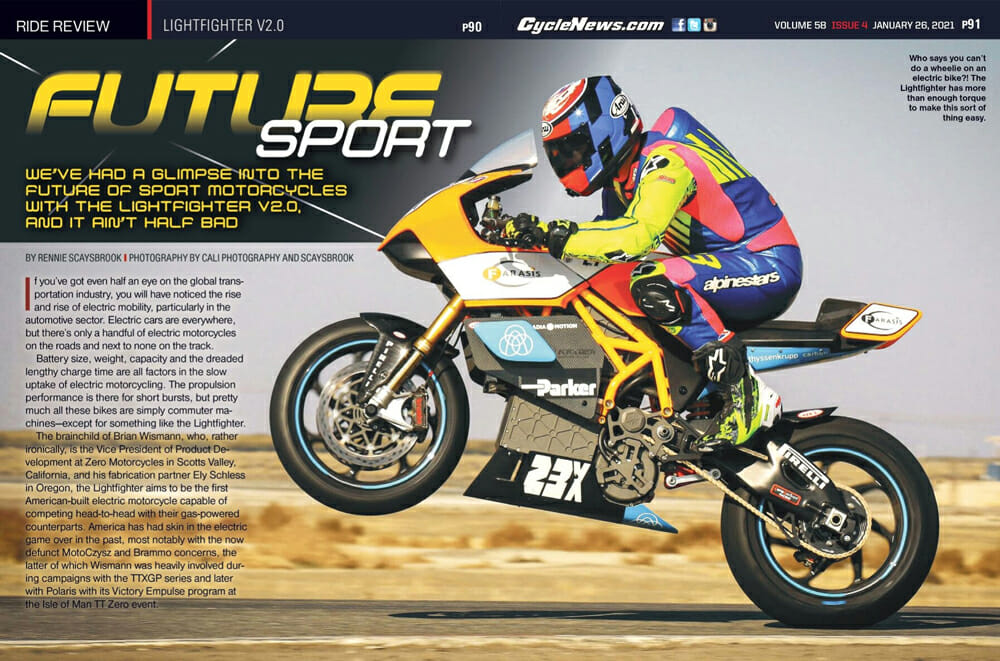Rennie Scaysbrook | January 30, 2021
We’ve had a glimpse into the future of sport motorcycles with the Lightfighter V2.0, and it ain’t half bad.
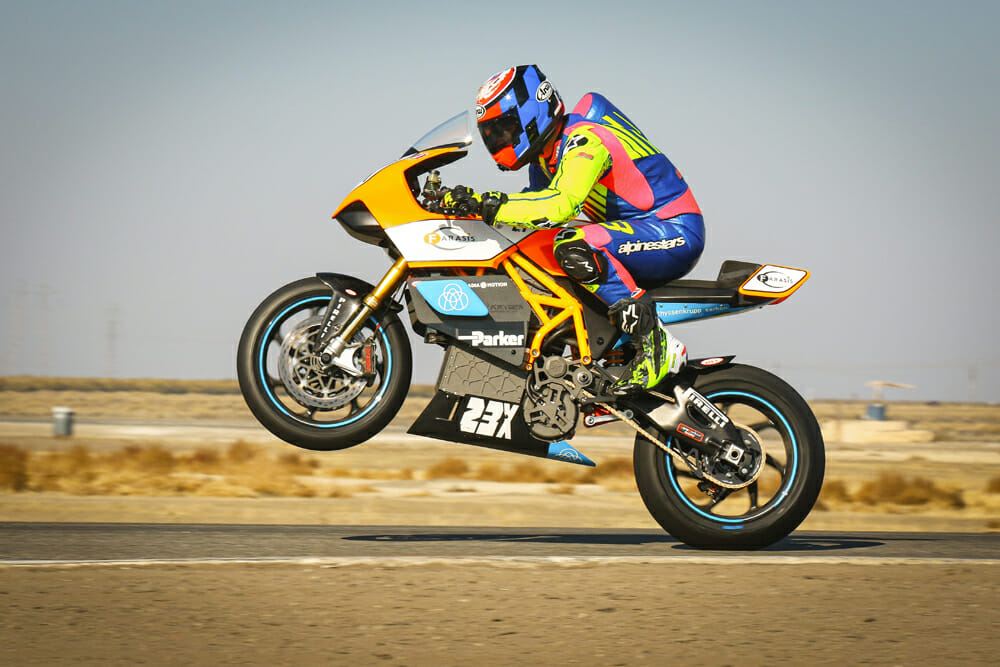 Who says you can’t do a wheelie on an electric bike?! The Lightfighter has more than enough torque to make this sort of thing easy.
Who says you can’t do a wheelie on an electric bike?! The Lightfighter has more than enough torque to make this sort of thing easy.
Photography by Cali Photography and Rennie Scaysbrook
If you’ve got even half an eye on the global transportation industry, you will have noticed the rise and rise of electric mobility, particularly in the automotive sector. Electric cars are everywhere, but there’s only a handful of electric motorcycles on the roads and next to none on the track.
Battery size, weight, capacity and the dreaded lengthy charge time are all factors in the slow uptake of electric motorcycling. The propulsion performance is there for short bursts, but pretty much all these bikes are simply commuter machines—except for something like the Lightfighter.
The brainchild of Brian Wismann, who, rather ironically, is the Vice President of Product Development at Zero Motorcycles in Scotts Valley, California, and his fabrication partner Ely Schless in Oregon, the Lightfighter aims to be the first American-built electric motorcycle capable of competing head-to-head with their gas-powered counterparts. America has had skin in the electric game in the past, most notably with the now defunct MotoCzysz and Brammo concerns, the latter of which Wismann was heavily involved during campaigns with the TTXGP series and later with Polaris with its Victory Empulse program at the Isle of Man TT Zero event.
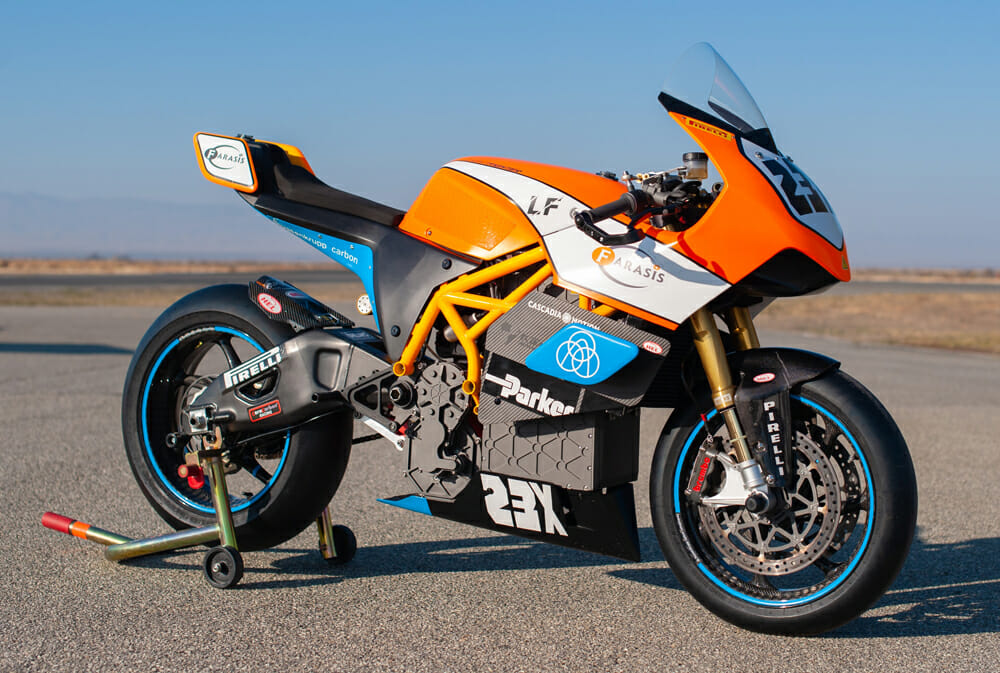 It looks like a Kramer, but that big grey block in the center of the frame hides a few secrets.
It looks like a Kramer, but that big grey block in the center of the frame hides a few secrets.
“It started dawning on me, being around more of these events, that what we ought to do is look at the things gas motorcycles are already doing really well and try to adapt this new powertrain to see if we can do it a little bit better,” says Wismann. “That’s where the Lightfighter idea was born. It is an electric motorcycle, like some of those other prototype electric motorcycles, but it’s considered geometry first.”
Lightfighter V2.0 Review | Finding The Balance
Wismann’s intentions were to create a motorcycle with very similar dimensions and tuneability to that of a gas bike. Housed in a custom chromoly trellis chassis fabricated in house by Schless, Wismann started with conservative 24° rake and 28mm trail numbers and adjustable triple-clamp offsets, and focused on making the center of gravity perfect to give nimble yet stable handling. Starting at this point and adapting the electric powertrain to the machine, rather than the other way around, set this project apart from the beginning.
“It was also important to come up with a bike that was about the same weight as gas bikes, because that’s what everybody’s tuned their suspension around and what we know works so well around a racetrack to begin with,” Wismann said. “Instead of a 600-pound, 300-horsepower monster, what we wanted to develop was something closer to a supersport bike that had a reasonable amount of power but weighed closer to 400 pounds or less. That was another big focus, and that’s one of the reasons we call it the Lightfighter.”
Wrapped in that tubular steel chassis sits a custom-built, liquid-cooled Parker-Hannifin GVM 210-100, constructed in the company’s New Ulm, Minnesota, factory.
“They designed it as a kit motor, so you can custom configure it for a bunch of different applications,” Wismann said. “So, in this case, it’s custom wound just for this bike. Then we take the core of the power and basically build the gearbox elements around it.
“This bike has about a 2:1 gear reduction built into it. So, it’s 162 Nm (119 lb-ft) motor but you double that through the gear reduction out to the rear wheel. Then that jack shaft and that gear reduction element allow us to put the countershaft where we want for the chain line forces on the swingarm, which is similar to what you would do on a gas bike.”
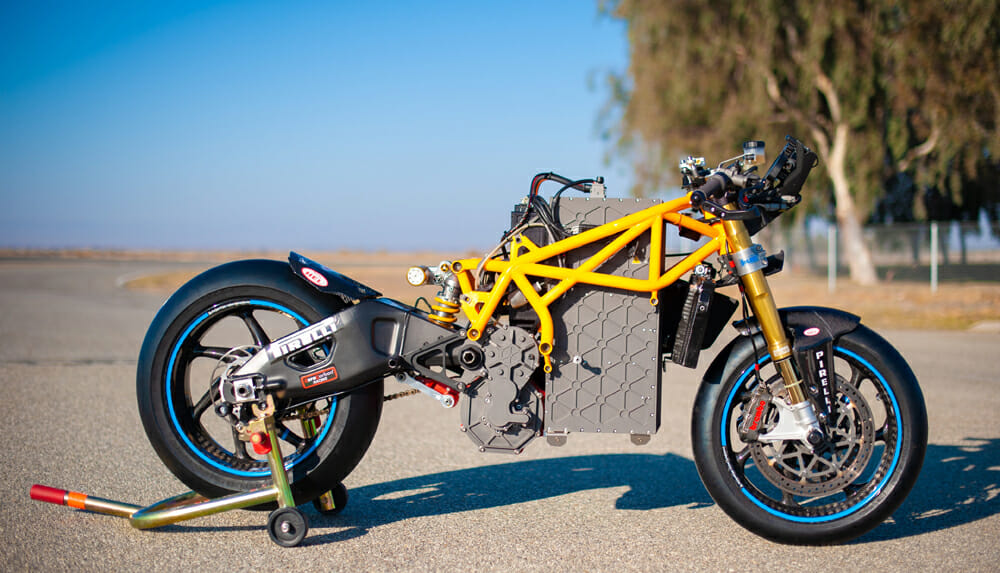 Sans clothes. There’s not much to the Lightfighter. Schless’s fabrication work on the chassis is superb.
Sans clothes. There’s not much to the Lightfighter. Schless’s fabrication work on the chassis is superb.
Powering the motor is an actively cooled, 410Vdc, lithium-ion NMC battery custom-made by Ely Schless using battery cells from Farasis Energy constructed in China. If you’re in the electric vehicle space you may know Farasis recently became one of the largest tier 1 suppliers for Daimler and so will be providing the company with cells for their upcoming line of EV cars.
All up, Wismann claims the Lightfighter produces 141 horsepower at 6800 rpm with torque measured at 120 lb-ft at 0-6800 rpm (remember that electric motors make all the available torque from zero rpm), and with the gear reduction of 2:1, makes for a very spicy ride.
The Lightfighter runs a MoTec CDL3 data logger dash that communicates over CAN with the motor controller itself.
“Between the battery and the motor is another device—the inverter. It takes the DC (direct current) power the battery provides and turns it into AC (alternating current) power for the motor,” Wismann says. “All electric cars and motorcycles these days run off permanent magnet AC motors, so you’ve got to invert the DC to AC.
“That motor controller itself also has some intelligence on it. We run a rudimentary traction control through the motor controller, but that motor controller communicates back up to the MoTec. That’s how we get all the data logged, and I can go back and look at data from the session, along with the GPS, of course.”
 410Vdc, Farasis Energy lithium-ion NMC on the left, mounted to the Cascadia Motion PM100DXR motor on the right. Throw in a 2:1 gear reduction, and you’ve got some serious go.
410Vdc, Farasis Energy lithium-ion NMC on the left, mounted to the Cascadia Motion PM100DXR motor on the right. Throw in a 2:1 gear reduction, and you’ve got some serious go.
Lightfighter V2.0 Review | Playing With Steel
Wismann, Schless and primary rider Troy Siahaan from Motorcycle.com are now onto version two of the chassis, learning lessons in stiffness from when the first machine saw track action 18 months ago.
“Troy raced version one with some pretty good success,” Wismann said. “We determined by the end of the season we thought the chassis was a little too stiff. In version two, we attempted to make some improvements by reducing overall stiffness and we think we’ve gone in the right direction. I’ve been watching with a lot of interest the developments that KTM has been able to make with their MotoGP program and even their off-road bikes. They’re doing some really cool things with the sections of steel on their steel frames. So, I’d love to experiment with that in the future, but so far, I’m pretty happy with this frame. The other kind of cool thing about the chassis is it comes up and over the battery, there’s two bolts per side that hold the battery into the frame.”
Battery changes take about 10 minutes when using a scissor lift, but the team has yet to construct a second battery, meaning everything on this bike is a one-off.
The swingarm is off a current-generation Yamaha YZF-R1, chosen firstly because the geometry was close to what Wismann wanted and because of its handling characteristics and flexibility. There’s no abstract thinking for the offsets for the shock, nor does it have strange routings for an exhaust—something obviously not needed with the Lightfighter.
“I literally bought one off eBay, did a 3D scan, and we started working around with the geometry, and it looked like it would work really well, and it has,” Wismann said.
 The Lightfighter has a number of different rear linkages at its disposal.
The Lightfighter has a number of different rear linkages at its disposal.
The swingarm linkages, so important in the overall concept of the Lightfighter, are custom made. “We have the stock linkage and then we have a couple of shorter linkages to play with the ride height,” Wismann says. “The bell crank position is actually on the motor itself, and it does change slightly compared to the gas-bike position. But we look at all of those influences and some suspension tuning spreadsheets and geometry packages and what we’ve got on there right now is a negative ten-millimeter link.”
Keeping the show rubber-side down is a set of pretty old-school but still very capable FGRT 210 Ӧhlins fork tubes and an Ӧhlins TTX36 shock, with the front brakes the beautiful dual 320mm T-slotted floating discs, mated to radially mounted Brembo CNC monobloc four-piston P34/38 racing calipers with titanium pistons, all squeezed by a Brembo RCS 19mm radial master-cylinder.
The rear brake is a bit different. It’s a scooter-style setup with the lever on the left handlebar (Jonathan Rea also runs this setup in WorldSBK), running a Magura 195 master-cylinder and a 220mm Superbike Unlimited rear disc matched to a Brembo Billet CNC twin-piston caliper.
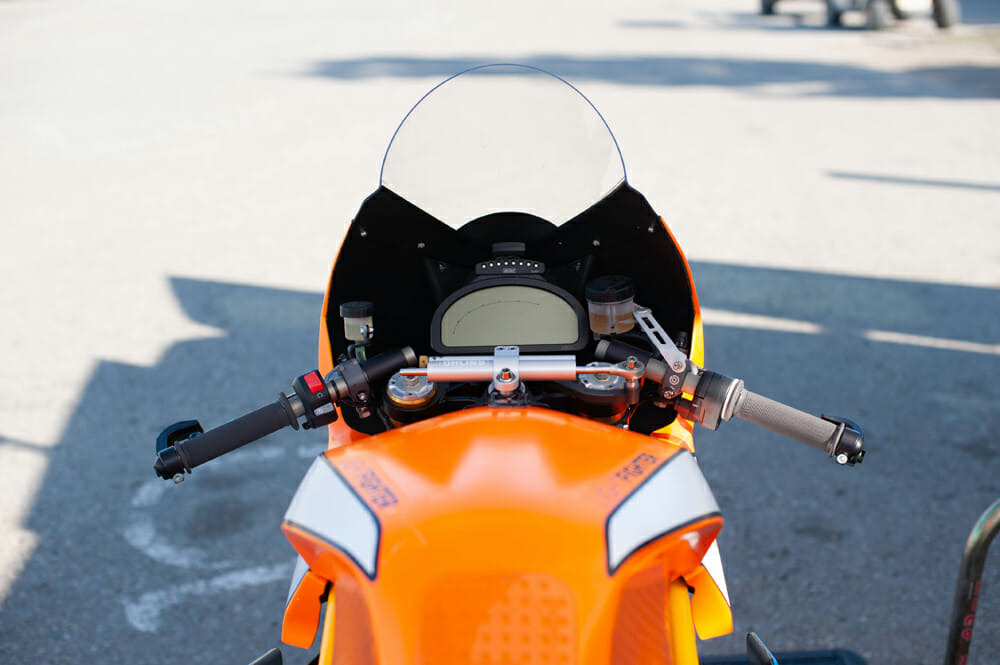 Mission control with the MoTeC dash. You can’t see it but the rear brake is where the clutch on a petrol bike would be.
Mission control with the MoTeC dash. You can’t see it but the rear brake is where the clutch on a petrol bike would be.
In true Lightfighter style, Wismann has chosen to fit a set of superb-looking and very light Thyssenkrupp Carbon Components carbon-fiber wheels from Germany.
“They’re a braided carbon construction,” Wismann says of the wheels. “They’re the lightest wheel I’ve ever held or weighed. Right now, our only limitation is really that they only offer a six-inch wide rear wheel. They’re still working on narrower wheel options. We would ideally like to run a 5.5-inch for the power and weight we’re at with the Lightfighter. But we’ve been playing around with the six-inch wheel and running some various size 200-width rear tires. It affects handling a little bit, but you do get some other gains. We pick up a little bit of top speed from a higher profile tire.”
If the bodywork looks familiar, it should. Wismann and Kramer Motorcycles have had a loose relationship since the project started, and the Lightfighter runs a modified version of the bodywork the Kramer HKR-EVO2 R and GP2 890 R machines use. The subframe and seat section is a self-supporting unit cast in carbon fiber by renowned Grand Prix fabricator Paul Taylor at Taylormade Racing.
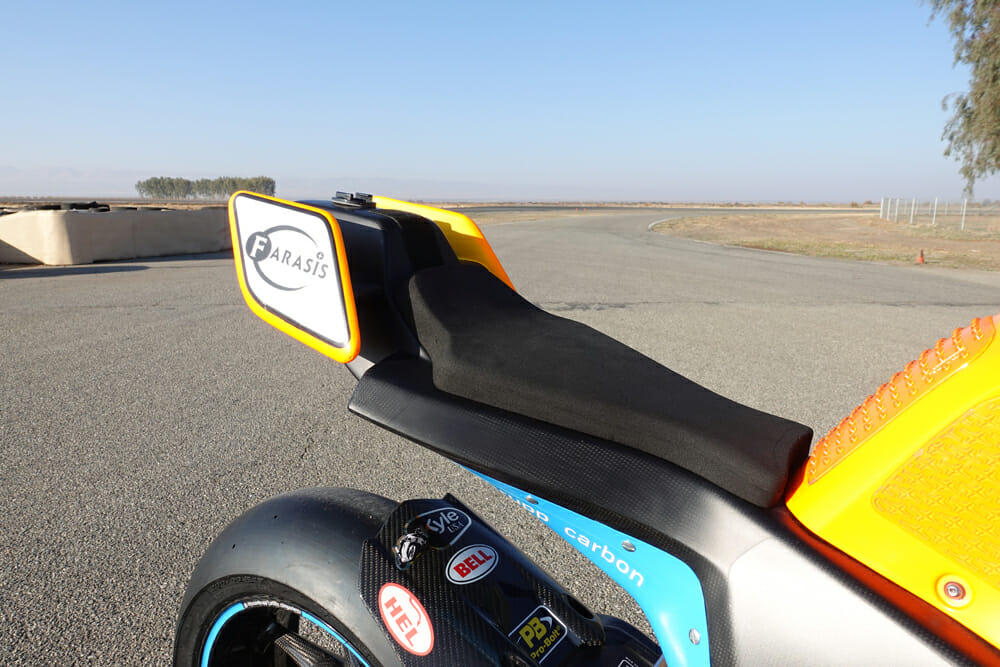 Self-supporting carbon-fiber seat unit/subframe weighs a mere two pounds without the seat foam.
Self-supporting carbon-fiber seat unit/subframe weighs a mere two pounds without the seat foam.
“One of the goals this year was to make a stiffer subframe, so I got in touch with Paul Taylor through another project we were working on and started throwing around some ideas,” Wismann says. “He showed me the carbon bike he put together for Moto2 back in the day, and it just snowballed from there. I did the CAD design on the seat unit in Alias and had a 3D print made of the final part. Then in a period of about two months, Paul turned it from that plastic 3D printed thing into the carbon-fiber piece you see here.
“The nice thing is he made carbon-fiber molds so now he can make more of them. I think the whole thing, without all the hardware and seat foam and stuff, was just under two pounds. He was really proud of that.”
Lightfighter V2.0 Review | From The Hotseat
VIDEO | Lightfighter V2.0 Electric Superbike Racer Track Test
When first climbing onto the Lightfighter, you notice how tall it is. Much like the Kramers I’ve tested in the past, you are perched very much on top of the saddle rather than in it, angling you towards the front for a more forward weight distribution.
Rolling out of the pits with nothing more than chain noise is a strange experience, and I admit I had not ridden an electric motorcycle on track since the Victory Empulse TT of 2015 (aside from the Zero FXS supermoto a few years ago).
But those concerns vanish the second the throttle is opened on the Lightfighter. The acceleration of this motorcycle is nothing short of immense. It’s here you realize the benefits of electric propulsion. The Lightfighter will simply rocket out of a corner, especially a slow-speed one, leaving gas-powered bikes up to 1000cc in its dust for the first half of the Buttonwillow front straight. There’s no hit of tire sacrificing power, just smooth, unadulterated torque that feels like you’re getting sucked along in a vortex.
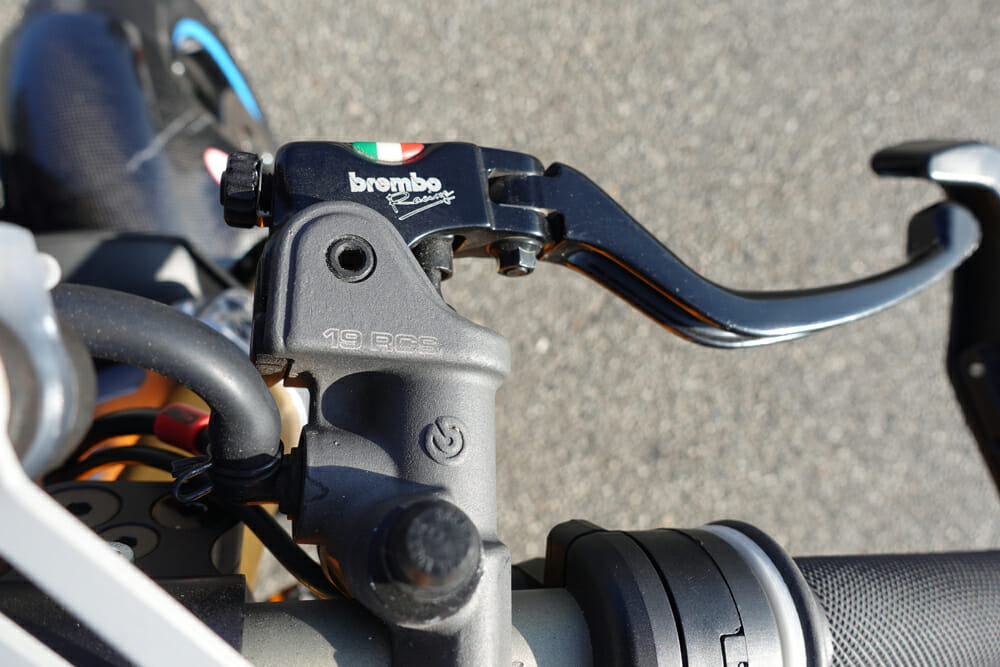 Brembo radial RCS 19mm master-cylinder controls the front brakes.
Brembo radial RCS 19mm master-cylinder controls the front brakes.
However, more impressive than the speed at which the Lightfighter gains momentum, is how Wismann’s mapped the throttle itself. So many electronic motorcycles have clunky throttle responses that ruin the crucial part of the corner when you slowly begin to dial in the go. Harley-Davidson managed to make a breakthrough here with the LiveWire, a motorcycle that has a very well mapped initial throttle opening. The Lightfighter takes that trick a step further—coming through the Sweeper corner at the back of the pits, you’re on the side of the tire for a long time, meaning a deft throttle response is crucial here if you want to remain on line for the exit.
The Lightfighter here is closer to a well-mapped gas bike than any electric machine I’ve ever ridden, allowing the rider to wind the power in fast and smooth without torturing the rear tire or running off line.
I found the Lightfighter to be a touch on the stiff side from the Ӧhlins suspension. But taking a couple of turns of preload out for the next session helped the Lightfighter sink into the stroke a bit more and load up the front better for heavy braking and the initial part of the turn.
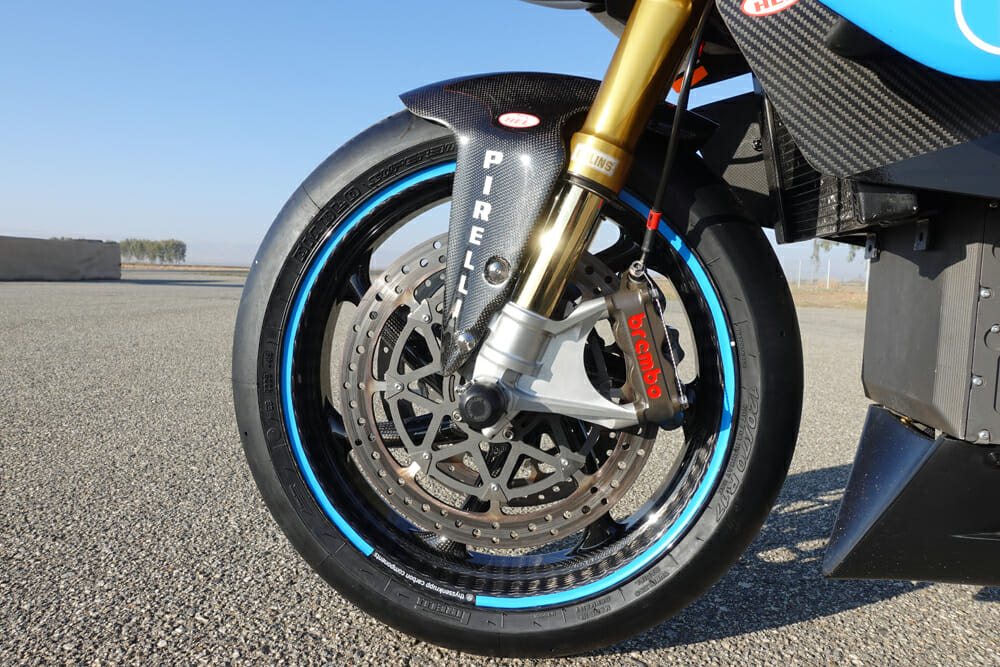 Ӧhlins forks are from the Ducati 1098/1198 era, but still work as good as any. The Brembo Monobloc calipers are also a similar vintage.
Ӧhlins forks are from the Ducati 1098/1198 era, but still work as good as any. The Brembo Monobloc calipers are also a similar vintage.
However, Wismann and Co. have done a good job reducing the overall chassis stiffness as it’s about as much as I’d have wanted. This isn’t a Grand Prix bike, after all, and it doesn’t hurt to have a little extra flex built into the chassis to give better feedback to the rider. As such, side of the tire feel is excellent on the Lightfighter—you’re always aware of what’s happening front and rear, and due to the neutral stance of the chassis, you’re able to change lines easily if required.
Once you’re on line and ready to pull the trigger, look out. The rush of torque and the lack of a gearbox mean you’re going faster, quicker, than almost anything else around you. It’s only up to when the 1000cc bikes hit fourth gear that you start to lose out. But then, due to vastly reduced weight, you can brake later and sail past them before the tip-in point. And here’s the best bit—because you’ve got all that torque, you can either ride it like a superbike by stopping at the apex and firing it out, or you can take a sweeping corner arc like a 600. It’s the best of both worlds.
Speaking of braking, the front performance is very good, but the rear brake is about five times as powerful as any production 1000cc machine I’ve ridden. If anything, it’s almost too powerful and will lock the rear if you’re really ham-fisted with it.
 Those wheels are pure sex.
Those wheels are pure sex.
I’m not a rear brake user at all but I am if it’s a hand-operated unit, like the thumb brake I had on my Pikes Peak Aprilia. You can brake incredibly late on the Lightfighter, using the masses of power from the front and rear brakes and the variable regenerative braking to pull you into the apex of the corner.
The Lightfighter is good for about 10 laps of full-on pace at Buttonwillow before power starts tapering off, which is enough to get you through a club race. This is close to what Brian wants but there will need to be a bit more range—or easy changeability of the battery pack—for the Lightfighter idea to really take hold.
At the end of my three sessions on the Lightfighter V2.0, I’m absolutely, positively buzzing. I’m happy for two reasons: it’s always nice to get a genuine surprise; and secondly, someone has finally built an electric motorcycle that has the potential to be a genuine challenger to gas machines. Best of all, it’s designed and almost entirely constructed in the USA with American partners.
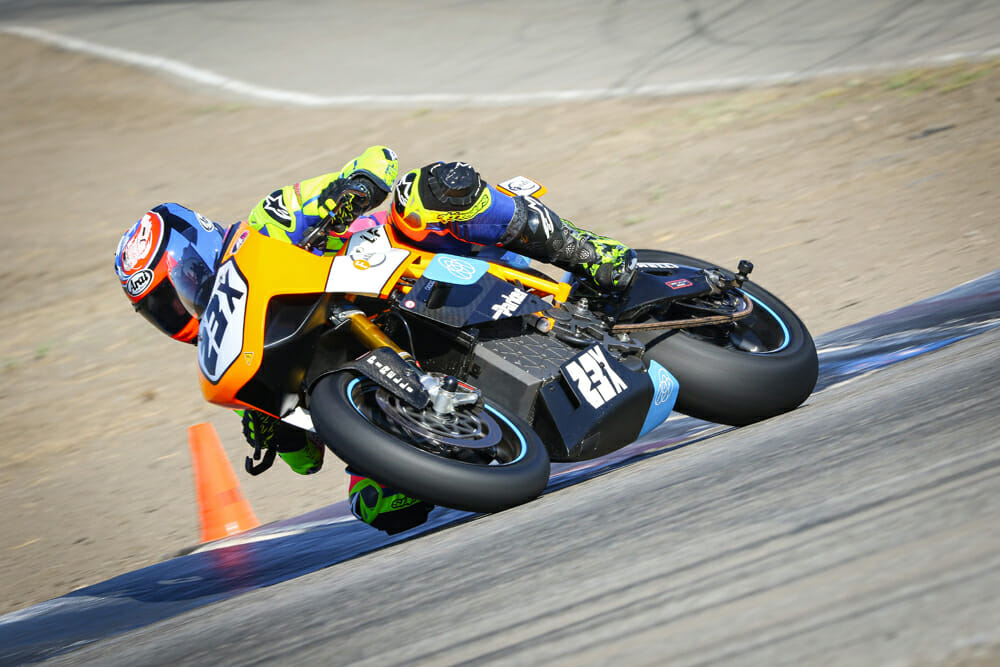 Bank the Lightfighter in and the chassis lets you know exactly what’s going on. Open the throttle and watch other bikes eat your electronic dust.
Bank the Lightfighter in and the chassis lets you know exactly what’s going on. Open the throttle and watch other bikes eat your electronic dust.
You can’t buy a Lightfighter—yet—but this may change in the coming years. “The Lightfighter is not technically for sale right now, although some discussions are underway,” says Wismann. “If you wanted to build a bike from scratch to the same specs with the nice Ӧhlins and Brembos as this one with myself and Ely putting it together, it would run around $45-50k.” So, in that regard, watch this space.
The Lightfighter is an extremely impressive machine and given its infancy and indeed that of the electric motorcycle space, the sky really is the limit.CN
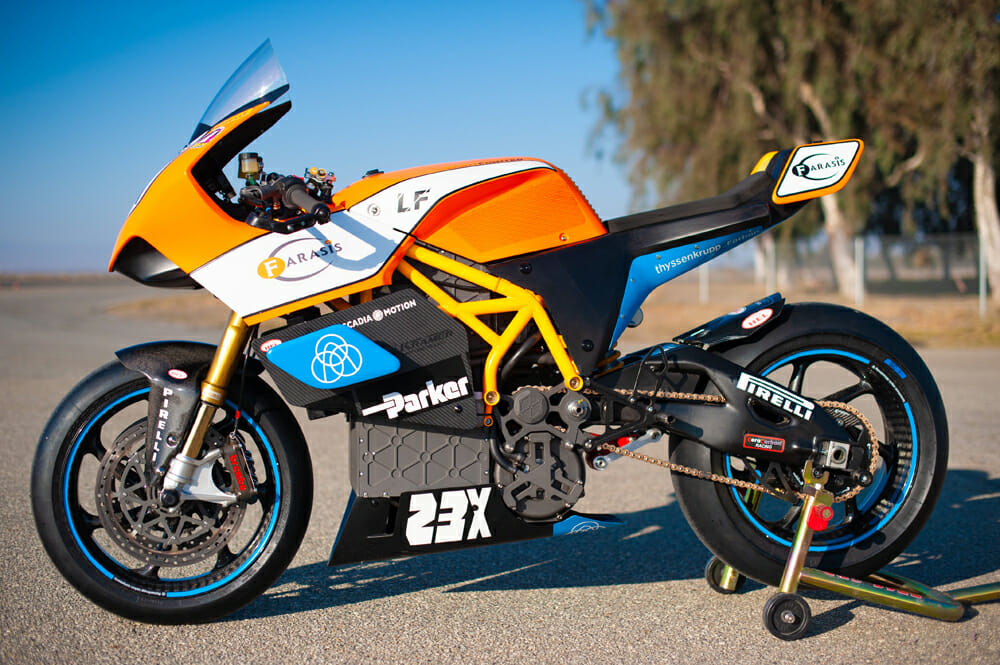
2020 Lightfighter V2.0 Specifications
| Motor: |
Parker GVM210-100 Permanent Magnet AC with integrated gear reduction, liquid-cooled |
| Battery: |
410Vdc, Farasis Energy lithium-ion NMC, actively cooled |
| Motor inverter: |
Cascadia Motion PM100DXR, liquid-cooled |
| Power (claimed): |
141 hp at 6800 rpm |
| Torque (claimed): |
120 lb-ft at 0-6800 rpm |
| Transmission: |
Direct Drive, gear reduction (2:1) |
| Clutch: |
None |
| Electronics: |
Motec CDL3 Data Logger Dash |
| Chassis: |
Chromoly steel trellis frame, fully stressed carbon fiber seat subframe |
| Front suspension: |
Öhlins FGRT 210 fully adjustable 30mm cartridge |
| Rear suspension: |
Fully adjustable Öhlins TTX36 unit, cast and fabricated aluminum Yamaha R1 OE swingarm with custom linkage (-10mm) |
| Front wheel: |
Thyssenkrupp Carbon Components braided carbon fiber 3.50 x 17 in. |
| Rear wheel: |
Thyssenkrupp Carbon Components braided carbon fiber 6.00 x 17 in. |
| Front brake: |
Dual 320mm T-slotted floating discs, radially mounted Brembo CNC Monobloc 4-piston P34/38 racing calipers with titanium pistons |
| Rear brake: |
220mm Superbike Unlimited rear disc, Brembo Billet CNC 2-piston caliper |
| Front tire: |
Pirelli Superbike Slick 120/70 ZR17 in. |
| Rear tire: |
Pirelli Superbike Slick 200/60 ZR17 in. |
| Rake: |
24.0° |
| Wheelbase: |
56.4 in. |
| Seat height: |
32.9 in. |
| Battery capacity: |
12kWh |
| Charge time: |
1h |
| Weight (claimed): |
399 lbs. |
